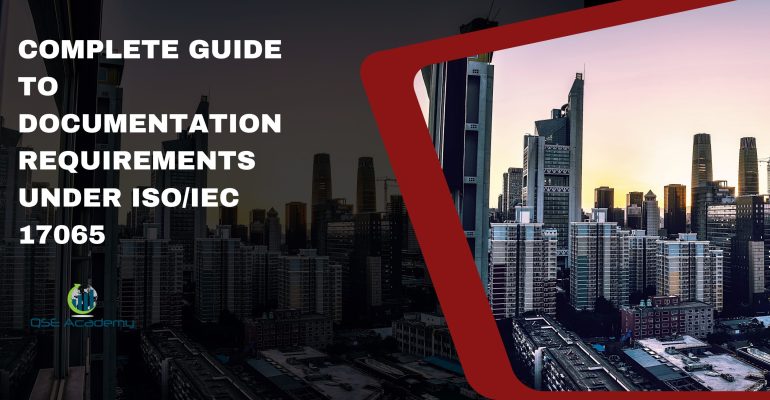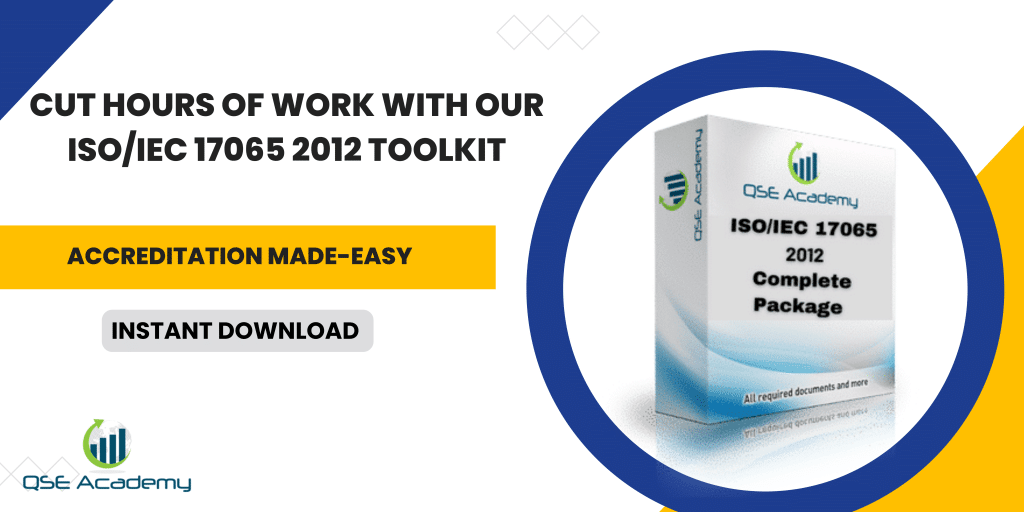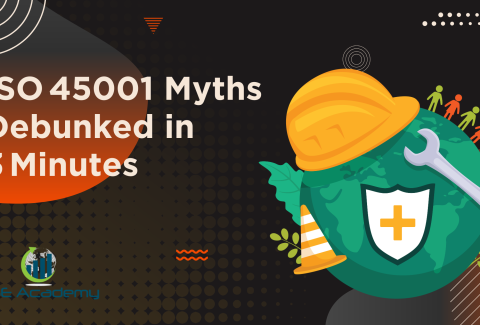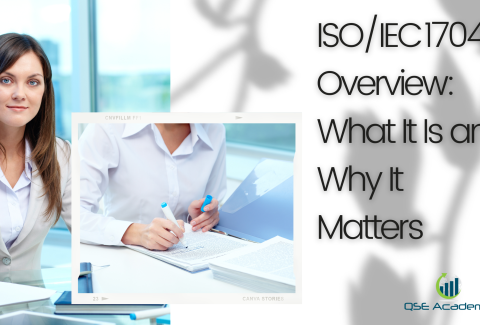Complete Guide to Documentation Requirements Under ISO/IEC 17065
Last Updated on December 23, 2025 by Hafsa J.
Complete Guide to Documentation Requirements Under ISO/IEC 17065
If you’re running a certification body, you already know that documentation is everything. It’s not just about keeping records—it’s about proving that your certification process is consistent, fair, and in line with international standards. That’s where ISO 17065 documentation requirements come in.
ISO/IEC 17065 sets the rules for organizations that certify products, processes, or services, ensuring that certification bodies operate impartially and competently. But here’s the catch: without the right documentation, proving compliance can become a major challenge. From outlining your certification process to maintaining clear decision-making records, documentation is what keeps your certification body audit-ready and legally sound.
But what exactly do you need to document? How much detail is enough? And how do you ensure your records aren’t just paperwork for the sake of paperwork, but actually useful tools for your team?
In this guide, we’ll break down ISO 17065 documentation requirements into simple, actionable steps. We’ll go over the essential documents you need, best practices for structuring them, and common mistakes to avoid. By the end, you’ll have a clear roadmap for creating documentation that’s not just compliant, but also practical and effective for your organization.
So, let’s dive in and make ISO 17065 documentation requirements as straightforward as possible!
Understanding ISO 17065 and the Role of Documentation
Now that we’ve established why ISO 17065 documentation requirements are so important, let’s take a step back and look at why they exist in the first place. If you’re running a certification body, your job is to evaluate and certify that products, services, or processes meet specific standards. But how do you prove that your certification process is fair, impartial, and consistently applied? The answer: clear and well-maintained documentation.
What Is ISO/IEC 17065?
ISO/IEC 17065 is an international standard designed to ensure that certification bodies operate in a way that is competent, consistent, and impartial. Whether you’re certifying organic food labels, safety equipment, or environmental standards, this framework guarantees that your certification decisions are reliable and trustworthy.
But having a solid certification process isn’t enough—you also need to document it properly. Without the right records, how can you demonstrate that you followed the correct procedures? This is why ISO 17065 documentation requirements play such a key role.
Why Documentation Is Critical in ISO 17065 Compliance
Let’s say an auditor walks into your office and asks, “Can you show me how you ensure impartiality in your certification process?” If you don’t have clear documentation, you might be left scrambling for an answer. But with a well-structured ISO 17065 documentation system, you can confidently show records that prove your organization follows the necessary procedures and safeguards.
Strong documentation helps in several ways:
- Ensures transparency – Every decision you make should be traceable. Documentation provides a clear record of how certification decisions were made.
- Standardizes processes – With proper documentation, your team follows the same certification steps every time, reducing errors and inconsistencies.
- Supports audits and reviews – When external auditors or regulatory bodies assess your certification body, well-maintained ISO 17065 documentation makes the process smooth and stress-free.
- Reduces risks – Clear records help identify and prevent potential conflicts of interest, ensuring that certification remains impartial and fair.
Without proper documentation, a certification body risks non-compliance, which could result in losing accreditation, facing legal issues, or damaging its reputation. That’s why ISO 17065 documentation requirements aren’t just a formality—they are essential for maintaining credibility and trust.
In the next section, we’ll go deeper into the specific documents required to meet ISO 17065 documentation requirements, so you’ll know exactly what to include and how to structure it for maximum clarity and compliance. Let’s keep going!
Key ISO 17065 Documentation Requirements
Now that we’ve covered why ISO 17065 documentation requirements matter, let’s get into the real question: What documents do you actually need?
If you’ve ever felt overwhelmed by documentation, you’re not alone! Many certification bodies struggle to find the right balance between compliance and practicality. You don’t want unnecessary paperwork, but you also can’t afford to miss critical documents that auditors will expect to see.
So, let’s break it down into mandatory documents and supporting records that will help you stay compliant while keeping your certification process smooth and efficient.
Mandatory Documents for Compliance
Certain documents are non-negotiable under ISO 17065 documentation requirements. These form the backbone of your certification body’s operations and prove that your process is consistent, impartial, and well-managed.
Quality Manual
Think of the quality manual as your organization’s playbook. It explains how your certification body meets ISO 17065 requirements, covering everything from organizational structure to decision-making processes.
This document should:
- Define the scope of your certification activities.
- Describe the key processes and responsibilities of your team.
- Explain how your organization ensures impartiality and consistency in certification decisions.
A well-structured quality manual ensures that everyone follows the same standards, making audits easier and reducing the risk of non-compliance.
Organizational Structure and Responsibility Documentation
Every certification body needs clear roles and responsibilities. This document outlines:
- Who is responsible for making certification decisions.
- How independence and impartiality are maintained.
- Reporting structures and lines of accountability.
Without this, there’s a risk of confusion, inconsistency, or even conflicts of interest in the certification process.
Certification Process Procedures
This is a must-have document that details how certifications are granted. It should outline:
- The steps of the certification process, from application to approval.
- Evaluation criteria and decision-making procedures.
- How certificates are renewed, suspended, or withdrawn.
Having a clear, documented process ensures that every certification follows the same standards, avoiding inconsistencies that could lead to disputes or compliance issues.
Risk Management Policies
ISO 17065 requires certification bodies to identify and manage risks—especially those related to impartiality. This document should cover:
- How your organization identifies potential risks to impartiality.
- The steps taken to mitigate these risks.
- Procedures for reviewing and updating risk management strategies.
By having a solid risk management framework, you can demonstrate compliance and avoid conflicts of interest in certification decisions.
Complaint and Appeal Handling Procedures
Disputes happen—it’s part of running a certification body. But ISO 17065 requires that complaints and appeals are handled fairly, consistently, and transparently.
Your documentation should:
- Explain how complaints and appeals are received, reviewed, and resolved.
- Define timelines for responses.
- Ensure that appeal decisions are made independently of the original certification decision.
Having a clear, documented process for handling complaints builds trust with clients and regulatory bodies, proving that your organization operates fairly and transparently.
Document Control and Record-Keeping Policy
Maintaining proper records is a key ISO 17065 documentation requirement. This includes:
- Ensuring that all certification decisions are documented and stored properly.
- Using version control to track updates to policies and procedures.
- Keeping records for the required retention period (as specified by ISO 17065 or industry regulations).
Without proper document control, you risk losing critical information or failing an audit due to outdated records.
Supporting Documents That Strengthen Compliance
Beyond the mandatory documents, there are additional records that can improve efficiency and compliance. While these may not be explicitly required by ISO 17065, they can help streamline operations and make audits easier.
Some useful supporting documents include:
- Internal audit reports – Helps track compliance performance and identify areas for improvement.
- Training records – Demonstrates that staff understand ISO 17065 documentation requirements and follow them correctly.
- Stakeholder communication policies – Outlines how your organization interacts with clients, regulators, and other stakeholders.
These documents provide extra assurance that your certification body is running smoothly, transparently, and in line with ISO 17065 standards.
Why These Documents Matter
If you’ve ever faced an ISO audit, you know that auditors want to see more than just a well-run operation—they need documented proof that you’re following ISO 17065 documentation requirements.
By having the right documentation in place, you can:
Make audits stress-free by having everything prepared and accessible.
Ensure consistency in certification decisions, reducing errors and disputes.
Build trust with clients and regulators by proving that your certification body operates fairly and transparently.
In the next section, we’ll go over best practices for structuring and managing these documents—so they’re not just sitting in a folder but actually helping your organization stay compliant and efficient. Let’s keep going!
Best Practices for Structuring and Managing ISO 17065 Documentation Requirements
Now that we’ve covered the essential documents required for compliance, the next big question is: How do you organize and manage them effectively?
Having all the right documents is great, but if they’re hard to find, outdated, or overly complicated, they won’t be much help when you need them—especially during an ISO audit. That’s why proper structuring and management of your ISO 17065 documentation requirements is just as important as the documents themselves.
Let’s go through some best practices to ensure your documentation is organized, accessible, and easy to maintain.
Keep Documentation Clear and Accessible
Let’s be honest—no one enjoys digging through confusing or cluttered files to find the information they need. A well-structured ISO 17065 documentation system makes it easy for your team to access important records quickly and efficiently.
Here’s how you can keep your documentation clear and accessible:
- Use a logical folder structure – Whether you’re storing files digitally or in physical binders, organize documents by category (e.g., “Certification Procedures,” “Risk Management,” “Complaints & Appeals”).
- Label documents properly – Use clear, standardized file names so that anyone can find what they need without guessing.
- Provide an easy-to-read index or table of contents – A simple document list helps employees and auditors locate key information faster.
- Use hyperlinks in digital documentation – If you’re using a shared system, hyperlink related documents to make navigation quick and efficient.
By making your ISO 17065 documentation requirements organized and user-friendly, you’ll not only make audits smoother but also help your team work more effectively.
Maintain Version Control to Track Updates
One of the biggest mistakes organizations make is not keeping track of document changes. ISO 17065 requires certification bodies to review and update documentation regularly, so version control is crucial.
Here’s how to ensure your documents are always up to date:
- Use version numbers – Label each document with a version number (e.g., “Certification Procedure v2.1”) so there’s no confusion about which one is current.
- Maintain a revision history – Keep a record of what changed, when it changed, and why. This helps during audits and internal reviews.
- Set regular review cycles – Assign someone to review and update ISO 17065 documentation requirements at least once a year (or more frequently if needed).
- Notify relevant team members of updates – Whenever a document is revised, ensure employees are aware of the changes so everyone follows the latest version.
Staying on top of version control helps prevent outdated procedures from being followed, reducing the risk of non-compliance or inconsistencies.
Balance Detailed Compliance with Practical Usability
One common challenge with ISO 17065 documentation requirements is finding the right balance between compliance and usability.
Too much detail? Employees won’t read it.
Too vague? You might fail an audit.
The key is to write documents that are both comprehensive and easy to use.
- Use plain language – Avoid overly technical jargon or legal-sounding language that makes documents hard to understand.
- Break information into sections – Use headings, bullet points, and numbered lists for clarity.
- Include flowcharts or visual aids – Sometimes, a simple diagram explaining a process is far more effective than a long paragraph of text.
- Think about the end user – Ask yourself, “If I were new to this organization, could I follow these documents easily?”
A well-structured ISO 17065 documentation system isn’t just about checking compliance boxes—it should actually help your team work smarter and more consistently.
Use Templates and Standardized Formats
To maintain consistency across all your ISO 17065 documentation requirements, using standardized templates is a smart approach.
- Create document templates – Develop templates for policies, procedures, reports, and checklists to ensure all documents follow a consistent format.
- Include required fields – Make sure each document template includes essential sections (e.g., purpose, scope, responsibilities, procedures, revision history).
- Ensure uniformity across all departments – Consistent formatting makes it easier to find information and maintain professionalism in documentation.
Using templates not only saves time but also reduces errors by ensuring all necessary information is included.
Train Staff on How to Use Documentation
Even the best documentation is useless if no one knows how to use it.
Training employees on ISO 17065 documentation requirements is crucial to ensuring they understand and follow the documented procedures.
- Include documentation training in onboarding – New employees should be introduced to key documents from day one.
- Hold refresher training sessions – Regular training ensures that existing employees stay updated on changes or new requirements.
- Provide quick-reference guides – A one-page summary of key policies and procedures can be a handy tool for employees.
- Encourage a culture of documentation awareness – Make sure employees feel comfortable accessing and using documentation in their daily work.
Well-trained employees are more likely to use documentation correctly, ensuring consistent compliance and reducing mistakes.
Why Effective Documentation Management Matters
A disorganized or outdated documentation system can lead to:
Missed compliance requirements that put your certification body at risk.
Confusion among staff about correct procedures.
Stressful audits due to missing or outdated records.
On the other hand, a well-managed documentation system means:
ISO audits become easier because everything is well-organized.
Employees follow consistent procedures, reducing errors.
Compliance risks are minimized, keeping your certification body credible.
By structuring and managing your ISO 17065 documentation requirements effectively, you’re not just creating records—you’re building a strong foundation for operational success.
What’s Next?
Now that you know how to structure and manage your documentation, let’s look at common mistakes organizations make—and more importantly, how to avoid them.
Let’s keep going!
Common Pitfalls and How to Avoid Them
So far, we’ve covered what ISO 17065 documentation requirements include, how to structure them effectively, and the best ways to manage them. But what about the common mistakes that trip organizations up?
Even with the best intentions, many certification bodies struggle with documentation, often making avoidable errors that lead to compliance issues, inefficiencies, and frustration during audits. Let’s take a look at some of the biggest pitfalls and how you can steer clear of them.
Overcomplicating Documentation
One of the most common mistakes is making documents way too complex. Some organizations think that adding more details, more pages, and more technical language will make their documentation stronger. But in reality, it just makes things harder to use.
A quality manual or procedure should be detailed enough to meet ISO 17065 documentation requirements, but also clear and practical for the people who actually need to follow it.
How to avoid this mistake:
- Write in plain language – If an employee or auditor can’t understand a document without legal or technical training, it’s too complex.
- Keep it concise – Get rid of unnecessary jargon, long-winded explanations, and redundant sections.
- Use visual aids – Flowcharts, checklists, and tables can simplify information better than blocks of text.
A good test? Hand a document to someone outside your team and ask if they understand it. If they struggle, it probably needs simplification.
Ignoring Regular Updates
Just because you’ve written your documentation once doesn’t mean you’re done forever. Many organizations create their ISO 17065 documentation and then forget about it, assuming it will always be relevant.
The problem? Regulations change, business processes evolve, and outdated documents can lead to non-compliance.
How to avoid this mistake:
- Schedule periodic reviews – Set a reminder to review and update documents annually or whenever significant changes occur.
- Assign a document owner – Someone should be responsible for keeping track of updates, industry changes, and compliance requirements.
- Track revisions properly – Always include version numbers and update histories to ensure you’re using the latest version.
Keeping documents updated and relevant ensures that your team is always working with the most accurate and compliant information.
Not Training Staff on Documentation
Even the best ISO 17065 documentation requirements are useless if no one knows they exist or how to use them.
Far too often, companies store documentation in a folder (physical or digital) and assume employees will read it on their own. The reality? Most won’t—unless you actively train them on its importance.
How to avoid this mistake:
- Make documentation training part of onboarding – New employees should be introduced to key ISO 17065 documentation from day one.
- Hold refresher training sessions – Even experienced staff need reminders, especially when documents are updated or revised.
- Make it interactive – Instead of just handing employees a thick manual, use workshops, scenario-based training, and Q&A sessions to engage them.
- Ensure easy access – If someone needs a document, they should know exactly where to find it without digging through a maze of files.
A well-trained team means fewer mistakes, better consistency in certification processes, and an easier time proving compliance during audits.
Failing to Align Documentation with Real Operations
Here’s a surprising problem: some organizations have beautifully written ISO 17065 documentation—but their actual day-to-day operations don’t match what’s in the documents.
This happens when documentation is written just to meet compliance requirements, rather than as a practical guide for real-world operations.
How to avoid this mistake:
- Involve employees in document creation – The people who actually do the work should have a say in how processes are documented.
- Test procedures in real situations – Before finalizing a process, make sure it works smoothly in practice.
- Update documents when processes change – If workflows evolve but documents don’t, your organization could be out of compliance without realizing it.
When your ISO 17065 documentation requirements accurately reflect real-world operations, compliance becomes a natural part of the workflow—not just a checklist for audits.
Poor Document Organization
Even if you have all the right documents, if they’re scattered, misnamed, or buried in random folders, you’ll waste time searching for them when you need them.
Disorganized documentation creates stress during audits, increases mistakes, and makes it harder for employees to follow procedures.
How to avoid this mistake:
- Use a consistent folder structure – Group documents into logical categories (e.g., “Certification Procedures,” “Complaints & Appeals,” “Risk Management”).
- Standardize naming conventions – Keep file names consistent and descriptive, so anyone can identify them at a glance.
- Use a document management system – If possible, store everything in a centralized, digital system that allows for easy searching and version control.
- Maintain a master index – A simple document list with hyperlinks (for digital files) or reference numbers (for physical files) helps everyone find what they need quickly.
A well-organized documentation system saves time, improves efficiency, and makes compliance much easier to maintain.
Why Avoiding These Pitfalls Matters
A certification body’s success depends on strong, well-managed documentation. If your ISO 17065 documentation requirements are clear, accessible, and aligned with actual operations, you’ll:
Have smoother audits because everything is well-organized.
Reduce compliance risks by ensuring processes are consistently followed.
Improve efficiency by making it easier for employees to access the right information.
Strengthen trust and credibility with clients, stakeholders, and regulators.
By avoiding these common documentation mistakes, your certification body will not only meet ISO 17065 documentation requirements—but also build a system that’s practical, user-friendly, and truly valuable for your organization.
What’s Next?
Now that you know how to avoid documentation pitfalls, let’s talk about how to ensure continuous compliance and improvement. Keeping your ISO 17065 documentation updated and relevant isn’t a one-time task—it’s an ongoing process.
Let’s dive into how to keep your documentation working for you in the long run!
Ensuring Continuous Compliance and Improvement
So, you’ve put in the work to create a well-structured and organized system for managing your ISO 17065 documentation requirements—great job! But here’s the thing: documentation isn’t something you set up once and forget about. It’s a living part of your certification body’s operations, and to keep it effective, you need a plan for continuous compliance and improvement.
The best certification bodies don’t just meet ISO 17065 documentation requirements—they actively maintain, review, and improve their documentation to ensure it remains useful, accurate, and aligned with both regulatory changes and real-world operations.
Let’s talk about how you can keep your documentation up to date and ensure ongoing compliance without the last-minute panic before an audit.
Conduct Regular Internal Audits
One of the best ways to ensure your documentation stays compliant is to audit yourself before the external auditors do. Internal audits help you:
Catch inconsistencies in documentation before an official audit.
Ensure that employees are following documented procedures.
Identify gaps where ISO 17065 documentation requirements might not be fully met.
Here’s how to make internal audits effective:
- Schedule them regularly – At least once a year, but preferably more often, depending on the size and complexity of your organization.
- Review both documents and real-world processes – Make sure that what’s written in your ISO 17065 documentation actually reflects what happens in daily operations.
- Get multiple perspectives – Involve employees from different departments to test the usability of your documentation.
- Act on findings – An audit is pointless if issues aren’t fixed. Create an action plan to resolve any discrepancies or improve unclear documentation.
By making internal audits a routine part of your compliance strategy, you avoid surprises during official audits and ensure ongoing alignment with ISO 17065 documentation requirements.
Keep Documentation Aligned with Regulatory Changes
ISO standards aren’t static—they evolve as industries grow, technologies improve, and best practices shift. That means your ISO 17065 documentation requirements need to adapt as well.
Here’s how to stay ahead of changes:
Monitor updates from ISO and regulatory bodies – Subscribe to ISO updates and industry newsletters to stay informed.
Participate in industry networks – Join relevant groups or attend conferences to discuss changes before they become mandatory.
Assign a compliance officer or team – Have a dedicated person or group responsible for tracking and implementing updates.
Review documents after regulatory changes – As soon as there’s an update to ISO 17065, compare it with your current documentation and make necessary revisions.
Waiting until the last minute to update your documentation can lead to non-compliance, so proactive updates will keep you ahead of the curve.
Make Documentation Readily Available and User-Friendly
Having updated documentation is only useful if people actually use it. If employees don’t know where to find key documents—or if the documents are too difficult to understand—compliance falls apart quickly.
Here’s how to ensure accessibility:
Centralize document storage – Whether you use a cloud-based system, a shared internal drive, or physical binders, ensure that employees know exactly where to find documentation.
Use search-friendly formats – PDF and Word documents should be searchable, and physical copies should be indexed properly.
Encourage regular use – Don’t let documentation collect dust! Encourage employees to reference it frequently and use it as a tool for decision-making.
Conduct quick refresher sessions – Sometimes a 5-minute team meeting reviewing a key process can reinforce compliance more than just telling employees to read a manual.
When documentation is easy to find and easy to use, compliance becomes second nature rather than an afterthought.
Train and Engage Employees on Documentation Updates
Even if you update your ISO 17065 documentation requirements regularly, it won’t help if your team isn’t aware of the changes.
Here’s how to keep everyone in the loop:
Announce updates clearly – Use team meetings, emails, or internal bulletins to inform employees about documentation changes.
Host training sessions – Make training interactive and scenario-based to help employees apply updated procedures in real-world situations.
Encourage feedback from staff – Your team members use these documents daily, so their insights on what’s working (or not) are invaluable.
When employees are actively engaged in documentation management, they become partners in compliance, rather than just following instructions.
Use Continuous Improvement Principles
Great documentation isn’t just about compliance—it’s also about efficiency and effectiveness. If there’s a better way to document a process, streamline a report, or make information clearer, take action!
Encourage feedback – Ask employees and auditors for suggestions on how to improve your documentation system.
Track recurring issues – If the same documentation problems keep appearing in audits, fix them permanently.
Leverage technology – Consider using document management software or automation tools to reduce manual effort and minimize errors.
By continuously improving your ISO 17065 documentation requirements, you don’t just stay compliant—you make your entire certification process more effective and future-ready.
Why Continuous Compliance Matters
Keeping your ISO 17065 documentation requirements up to date isn’t just about meeting regulatory expectations—it’s about ensuring that your certification body runs smoothly, efficiently, and transparently.
Well-maintained documentation = smoother audits – No last-minute scrambling when auditors request records.
Updated documentation = reduced compliance risks – Avoid fines, penalties, or loss of accreditation due to outdated policies.
Engaged employees = consistent application of procedures – When employees understand and trust the documentation, they follow it correctly.
Ongoing improvements = long-term success – A proactive approach to documentation keeps your certification body credible and competitive.
By treating documentation as a living, evolving part of your operations, you’re not just checking compliance boxes—you’re building a foundation for lasting success.
What’s Next?
We’re almost at the finish line! Now that we’ve covered how to keep your ISO 17065 documentation requirements updated and relevant, let’s bring it all together with a final recap and key takeaways.
Let’s wrap this up!
Conclusion: The Key to Strong ISO 17065 Documentation Requirements
We’ve covered a lot about ISO 17065 documentation requirements, and by now, you should have a clear roadmap for managing documentation in a way that’s not only compliant but also practical and effective for your organization.
At its core, documentation isn’t just about meeting audit requirements—it’s about creating a transparent, reliable, and well-structured certification process. When properly managed, documentation helps certification bodies:
Ensure consistency in certification decisions
Reduce compliance risks by keeping policies clear and up to date
Make audits smoother by having all required records in place
Improve operational efficiency by providing a clear guide for employees
Build trust with stakeholders through transparent and well-documented processes
But here’s the thing: ISO 17065 documentation requirements aren’t a one-time task. They’re an ongoing commitment to quality, transparency, and improvement.
Final Takeaways on ISO 17065 Documentation Requirements
- Keep documentation clear and accessible – Your team should be able to find and use key documents easily.
- Review and update documents regularly – Compliance isn’t static; keeping documentation up to date prevents last-minute surprises.
- Train employees on documentation – A well-informed team ensures processes are followed consistently.
- Use best practices to structure documentation – Organized, well-formatted documents make compliance easier and more effective.
- Avoid common pitfalls – Overcomplication, outdated records, and poor organization can lead to compliance headaches.
By following these principles, your ISO 17065 documentation requirements won’t just be about checking a box for compliance—they’ll become a valuable asset that helps your organization run smoothly, make better decisions, and maintain credibility in the certification industry.
What’s Next?
Now that you understand how to manage ISO 17065 documentation requirements effectively, it’s time to take action!
Review your current documentation – Identify any gaps or outdated records.
Schedule a regular review cycle – Ensure continuous compliance with ISO 17065 standards.
Train your team – Make sure employees know where to find documentation and how to use it.
Improve your system – If documentation isn’t working for you, refine it to make it clearer, simpler, and more efficient.
By making documentation a living, breathing part of your organization, you’re not just complying with ISO 17065 documentation requirements—you’re setting up your certification body for long-term success.
So, are you ready to turn your documentation into a strategic advantage? Let’s make it happen!
I hold a Master’s degree in Quality Management, and I’ve built my career specializing in the ISO/IEC 17000 series standards, including ISO/IEC 17025, ISO 15189, ISO/IEC 17020, and ISO/IEC 17065. My background includes hands-on experience in accreditation preparation, documentation development, and internal auditing for laboratories and certification bodies. I’ve worked closely with teams in testing, calibration, inspection, and medical laboratories, helping them achieve and maintain compliance with international accreditation requirements. I’ve also received professional training in internal audits for ISO/IEC 17025 and ISO 15189, with practical involvement in managing nonconformities, improving quality systems, and aligning operations with standard requirements. At QSE Academy, I contribute technical content that turns complex accreditation standards into practical, step-by-step guidance for labs and assessors around the world. I’m passionate about supporting quality-driven organizations and making the path to accreditation clear, structured, and achievable.










